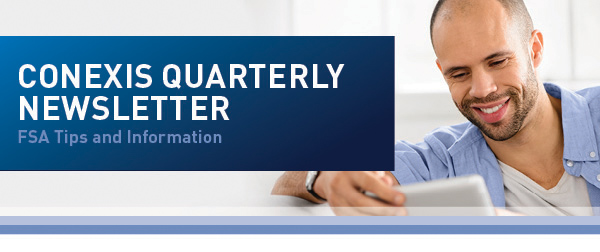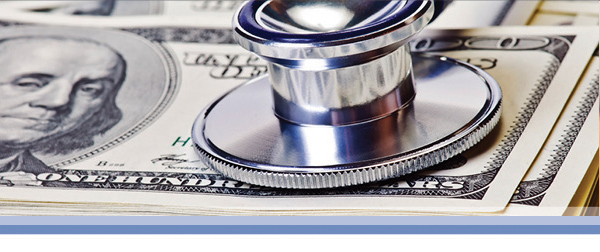
|
| Q2 2013 |
Date of Publication: April 17, 2013 |
| GET MORE BANG FROM YOUR FSA BUCKS
|
|
| Knowing the ins and outs of your flexible spending account (FSA) helps you maximize your FSA funds. Whether you’re an FSA pro or this is your first time to have an FSA, it’s helpful to keep up with your funds throughout the plan year.
|
| Log In to Tune In
|
| When was the last time you checked out your CONEXIS online account? Log in today to see your real-time account balance, claims status, and reimbursement history. While there, it’s easy to submit online claims and review eligible expenses. And if you haven’t done so already, enroll in direct deposit — it’s the quickest way to receive a reimbursement. |
| Be in the Know
|
| The Internal Revenue Service (IRS) regulates FSAs. It sets the rules — we all have to follow them. Here are some of the key points you need to be aware of:
|
- Know what’s available. With a health FSA, your entire election amount is available to use the first day of the plan year. However, your dependent care FSA funds are only available as the money is deducted from your paycheck. As long as your health FSA or dependent care FSA funds are available, you can use that money toward eligible expenses. Check out the hundreds of eligible expenses and savings examples on our website.
- Save all receipts. Keeping track of your FSA is essential. When submitting a health FSA claim, send us copies of your itemized receipts or other supporting documentation with specific details related to the eligible expense. For example: eligible over-the-counter health care-related products require you to submit an itemized cash register receipt with the merchant name, name of the item/product, date, and amount along with your Request for Reimbursement form. Learn more …
- Plan to spend. The IRS has a "use-it-or-lose-it" rule that requires you to use all of your FSA funds toward eligible expenses by the end of your coverage period. Remaining FSA dollars won’t be returned to you, paid in cash or other benefits, or rolled over to the next plan year. Consider making a plan for spending your available funds before time runs out. Some FSA plans may include a grace period or run-out period, so see your Summary Plan Description (SPD) for details.
- No double-dipping, please. With your FSA, only eligible out-of-pocket expenses are reimbursed. You can’t double-dip and use FSA funds to pay for expenses previously reimbursed by your FSA or covered by any other plan or program. For example, you can’t submit a reimbursement request for a smoking cessation program under your FSA and use funds from your employer’s wellness program to cover the same expense. Plus, you can’t claim any federal income tax deduction or credit for expenses reimbursed under your FSA.
|
|
|
|
| Need to submit a reimbursement request? Just complete a Request for Reimbursement form and submit it along with your supporting documentation. The simplest way to do this is through your online account. You can also submit a claim by fax or mail using the fax number or address listed on your claim form, which can be downloaded from your online account. |
|

|
| SPEND LESS, SAVE MORE ON HEALTH CARE
|
|
| As health care costs continue to rise, so does the number of us seeking to save on these costs. Your FSA is a smart move in that direction. Take it a step further with these tips: |
- Know your benefits. Since each health plan can vary, take time to read your health plan policy. Learn what’s covered and what’s not, as well as other essential details. In addition, staying within your health plan’s provider network will help save money.
- Make the call. Many health plans offer a free 24/7 nurse line. Calling it could help you decide if you need to see a health care provider, and even which provider to use. This may save you money in the long run.
- Compare prescription drug costs. Drug costs vary by merchant. Shop around by calling various stores around you or going online to compare prices. You can even buy your prescription drugs at the big wholesalers without having memberships. If okay with your doctor, consider getting the generic prescription and over-the-counter drugs for the greatest savings.
- Check your bills. Just like your bank statement or any bill, it’s wise to check your Explanation of Benefits (EOB) statements and other health care bills for costly errors. If a cost for a service doesn’t look right, give your health plan or doctor a call.
- Kick bad habits. Bad habits may hurt your health as well as your pocketbook. Make 2013 the year to lose weight, quit smoking, etc. See if your health plan provides support or incentives for these. If not, your FSA funds may cover certain expenses prescribed by a doctor to treat a diagnosed medical condition, such as a weight loss or smoking cessation program. Learn more on our website.
|
|
|
|

|
| 877.CONEXIS | WWW.CONEXIS.COM
|
| This email was sent by:
|
CONEXIS
6191 North State Highway 161, Suite 400
Irving, TX 75038
|
| This email was sent from an unmonitored email address. While we cannot receive replies at this email address, we're happy to help you with any questions or concerns you may have. Please log in to your account at mybenefits.conexis.com and visit the "Contact Us" page for more information.
|
| CONEXIS does not offer medical, legal, accounting, or other professional advice. If you need additional guidance, please contact your doctor, attorney, or tax advisor.
|
| CONEXIS uses reasonable efforts to ensure that the information provided in this document is accurate as of the date of publication.
|
| ©2013 CONEXIS Benefits Administrators, LP. All Rights Reserved. CONEXIS is a Word & Brown Company. No part of this publication may be reprinted without the written permission of CONEXIS.
|
| View our Email Privacy Policy | Unsubscribe
|
|


